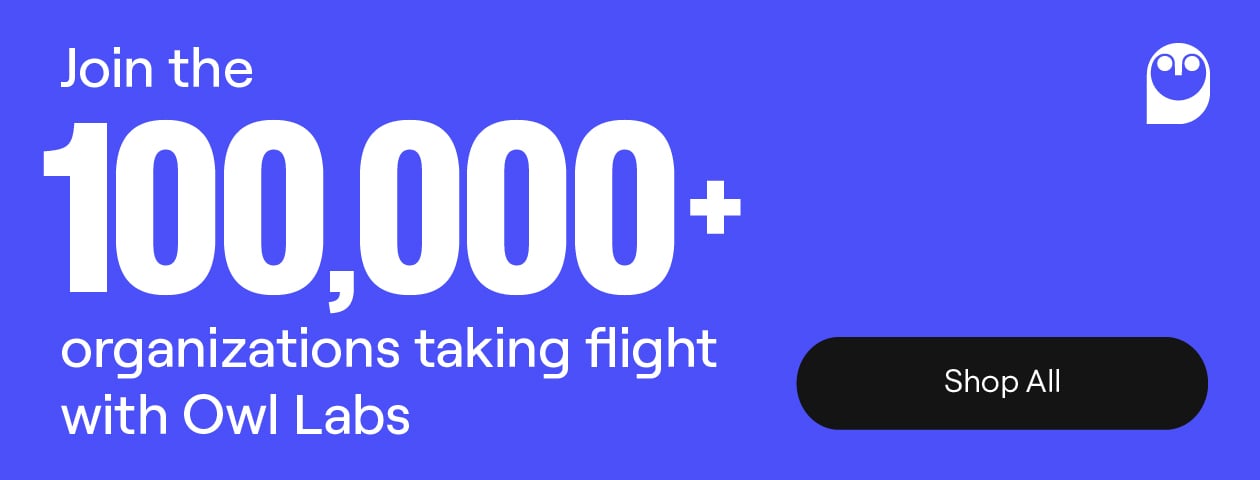Effective collaboration is essential for driving innovation and success in today's fast-paced business world. For enterprise businesses navigating the challenges of the modern workplace, embracing hybrid collaboration tools is key to unlocking seamless communication and productivity.
As enterprise businesses transition to hybrid work models, the demand for advanced enterprise collaboration tools has surged. Traditional meeting setups are no longer sufficient in a world where remote and in-person teams must seamlessly collaborate, even when they aren’t physically together. This is where enterprise hardware for hybrid collaboration can shine, providing the flexibility, scalability, and support necessary for success.
According to the 2023 State of Hybrid Work report, hybrid work is gaining momentum, with 26% of respondents already immersed in hybrid environments and another 25% saying that they would trade 15% of their salary for flexible hours.
During the pandemic, many enterprise businesses transitioned to remote work (as we all had to), but since restrictions have been lifted, we’ve seen a drastic shift in the way large-scale companies consider hybrid work - and the tools needed to enable effective hybrid work.
For example, Dell is actively working to bring more employees back into the office, but they are avoiding a forced mandate. The technology giant recently announced that remote employees are welcome to continue working remotely, but only employees who return to the office will be eligible for promotions. This interesting approach gives employees flexibility in choosing their work environment while incentivizing a return to the office.
Google, a company that makes many of the tools that remote workers rely on, like Google Meet and Google Drive, has doubled down on their decision to bring employees back into the office. It wasn’t too long ago that tech giants like Google were leading the charge towards remote work. Now, the big players like Meta, Apple, and Google have all changed their tune and are actively working to shift their employees back towards in-office work.
This shift towards hybrid work provides employees with flexibility, but also brings with it challenges that enterprise businesses need to address if they want to retain talent and productivity. Chief among those challenges is finding the right tools to enable effective hybrid work at such a large scale. Let’s take a closer look at what these businesses should be considering when embracing hybrid work.
Strategies for creating sustainable hybrid work practices
Employee preferences: One of the first things companies should consider when transitioning to a hybrid work model is the preferences of their employees. While some may thrive in a remote environment, others may prefer the structure and social interaction of the office. By conducting surveys or holding discussions with employees, companies can gain valuable insights into their preferences and tailor their hybrid work policies accordingly.
Communication and collaboration: Effective communication and collaboration are essential for the success of any hybrid team. Companies should invest in enterprise hardware and technologies that enable seamless communication between remote and in-office employees. This includes video conferencing platforms, instant messaging apps, and project management tools that facilitate real-time collaboration and information sharing.
Flexibility and accessibility: Hybrid work models offer employees greater flexibility in terms of where and when they work. However, it's essential to ensure that all employees have access to the resources and support they need to be productive, regardless of their location. This may involve providing remote employees with the necessary hardware, such as laptops and ergonomic furniture, as well as offering flexible working hours to accommodate different schedules.
Maintaining company culture: Building and maintaining a strong company culture can be challenging in a hybrid work environment. Companies should proactively find ways to foster connections and camaraderie among remote and in-office employees. This could include organizing virtual team-building activities, hosting regular town hall meetings, or creating online communities where employees can connect and socialize.
Balancing workload and expectations: In a hybrid work model, it's essential to establish clear expectations and guidelines for employees to ensure that everyone is on the same page. This includes defining work hours, setting goals and deadlines, and establishing protocols for communication and collaboration. Managers should also be mindful of the potential for burnout and take proactive steps to support their team members' well-being.
The technology teams need to succeed
When it comes to hardware and software solutions for hybrid work, companies need enterprise technology solutions that are versatile, reliable, and easy to use. Here are a few key considerations:
Video conferencing solutions: Investing in high-quality video conferencing solutions is essential for facilitating seamless communication and collaboration in a hybrid work environment. Look for platforms that offer features like HD video, crystal-clear audio, and intelligent learning to enhance the meeting experience for remote participants.
Collaboration tools: Collaboration tools such as project management software, document-sharing platforms, and virtual whiteboards are crucial for keeping remote and in-office teams aligned and productive. Choose solutions that easily integrate with your existing workflows and offer features that support remote collaboration, such as real-time editing, version control, and task assignment.
Hardware devices: Providing employees with the right hardware devices is important for ensuring that they can work effectively from anywhere. Consider investing in enterprise technology solutions like high-quality webcams, headsets, ergonomic keyboards, and dual monitors to create a comfortable and productive remote work environment.
Owl Labs' Solutions for Seamless Collaboration
At Owl Labs, we understand the unique challenges of transitioning to a hybrid work model, and we're here to help. Our ecosystem of devices is specifically designed to facilitate seamless communication and enterprise collaboration in hybrid work environments. With solutions like the Meeting Owl 4+, Owl Bar, Whiteboard Owl, and Expansion Mic, enterprise businesses can unlock the full potential of hybrid collaboration, empowering their teams to connect, communicate, and collaborate with ease, regardless of location or distance. Join the hybrid revolution today and discover a new era of hybrid collaboration for your enterprise business.
%20(1).png)
Better meetings start here
From huddle rooms to boardrooms and everything in between, we’ve got you covered with solutions that take teamwork to the next level.
Shop Solutions